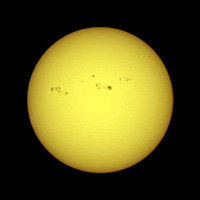Powerful ’conveyor belts’ drive Sun’s 11-year cycle, new evidence suggests

Sunspots appear as dark spots on the Sun’s surface. (Big Bear Solar Observatory/New Jersey Institute of Technology)
NASA and university astronomers have found evidence the 11-year sunspot cycle is driven in part by a giant conveyor belt-like, circulating current within the Sun.
The astronomers, Dr. David Hathaway, Robert Wilson and Ed Reichmann of NASA’s Marshall Space Flight Center in Huntsville, Ala., and Dr. Dibyendu Nandy of Montana State University in Bozeman, reported their findings the week of June 16 at the annual meeting of the Solar Physics Division of the American Astronomical Society in Laurel, Md. The results were also published in the May 20 issue of the Astrophysical Journal.
The astronomers made their discovery by reviewing the positions and sizes of all sunspots seen on the Sun since 1874. “The sunspots appear in two bands on either side of the Sun’s equator,” said Hathaway. “Although the individual sunspots come and go from week-to-week, the central positions of the bands in which they appear drift slowly toward the solar equator over the course of each 11-year sunspot cycle.”
Previously, scientists believed this equator-ward drift was a wave-like process involving magnetic forces. However, this new evidence suggests this drift is produced by a giant circulation system in which the compressed gases, 125,000 miles below the Sun’s surface, move from the Sun’s poles to its equator at about three mph — a leisurely walking pace. The gases then rise near the equator and turn back toward the poles, traveling in the surface layers where the gas is less compressed — moving at a faster rate of approximately 20 to 40 mph. Recent progress in theoretical modeling of the sunspot cycle has emphasized the important role of this circulation.
The speed of this circulation system, called a meridional circulation, changes slightly from one sunspot cycle to the next. The circulation is faster in cycles shorter than the average 11-year period and slower in cycles longer than the average period. This is a strong indication that this circulation acts like an internal clock that sets the period of the sunspot cycle.
The circulation also appears to influence the strength of future cycles, as seen in the number and sizes of the sunspots produced, not in the cycle immediately following, but rather in a two-cycle or 22-year time lag. When the flow is fast, it concentrates the magnetic field at the Sun’s poles. These stronger fields are then transported downward into the solar interior where they are further compressed and amplified to become the intense magnetic fields that form sunspots years later.
The Sun is now in the declining phase of the current sunspot cycle that peaked in 2000 and 2001. Because the circulation flow was fast during the previous cycle, the astronomers believe the next cycle will be a strong one, peaking in the years 2010 and 2011.
Contact: Steve Roy, steve.roy@msfc.nasa.gov
Media Contact
More Information:
http://www.msfc.nasa.gov/newsAll latest news from the category: Physics and Astronomy
This area deals with the fundamental laws and building blocks of nature and how they interact, the properties and the behavior of matter, and research into space and time and their structures.
innovations-report provides in-depth reports and articles on subjects such as astrophysics, laser technologies, nuclear, quantum, particle and solid-state physics, nanotechnologies, planetary research and findings (Mars, Venus) and developments related to the Hubble Telescope.
Newest articles

Innovative 3D printed scaffolds offer new hope for bone healing
Researchers at the Institute for Bioengineering of Catalonia have developed novel 3D printed PLA-CaP scaffolds that promote blood vessel formation, ensuring better healing and regeneration of bone tissue. Bone is…

The surprising role of gut infection in Alzheimer’s disease
ASU- and Banner Alzheimer’s Institute-led study implicates link between a common virus and the disease, which travels from the gut to the brain and may be a target for antiviral…

Molecular gardening: New enzymes discovered for protein modification pruning
How deubiquitinases USP53 and USP54 cleave long polyubiquitin chains and how the former is linked to liver disease in children. Deubiquitinases (DUBs) are enzymes used by cells to trim protein…


